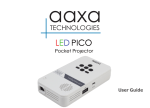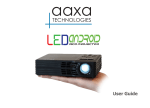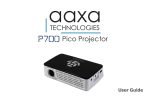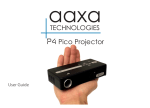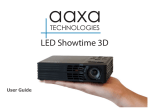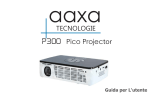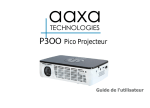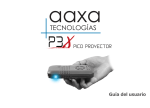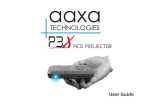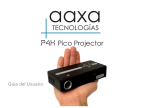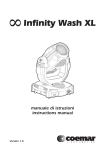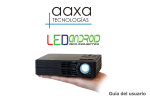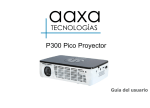Download User-Manual - AAXA Technologies
Transcript
aaxa TECHNOLOGIES M4 Pico Projector User Guide Caution! WARNING: Please use this product as instructed. Misuse may cause injury or death. DO NOT use while driving DO NOT expose to water or wet surfaces. Electric shock may occur. DO NOT expose the projected LED image to your eyes or the eyes of others DO NOT block or restrict airflow from ventilation holes as this may cause the projector to overheat Keep the projector, battery, or charger away from any heat sources Caution for Battery Use • • • Do not pierce or puncture the battery with sharp objects Do not heat the product or expose it to high temperature. Do not wet it or place it in any liquid Caution for Headphone Use • • Prolonged use at high volume may impair your hearing. High volume during walking or driving may cause distractions and result in injury or death Table of Contents 1 Chapter 1: M4 at a glance Main Unit Front/Back 2 Remote & Keypad 3 Accessories 4 Chapter 2: Getting Started 5 Powering On / OFF 6 FocusAdjustment / Throw Distance 7 Battery Pack Information 8 Connecting to a Computer VGA Connecting to a Computer HDMI 10 Connecting to HDMI Video 12 DTV Setup 14 17 18 20 22 23 25 26 28 29 31 32 39 Connecting to Speaker or Headphones Connecting a Micro SD Card Connecting to a USB Host Chapter 3: Menu Screens Main menu Video Player Menu Video FAQ Photo Viewer Menu Photo FAQ Music Player Menu Music FAQ Setup Menu Keystone Adjustments 41 Chapter 4: Technical Details Troubleshooting Specifications 1 Chapter 1 M4 at a Glance Main Unit Front/Back Power Button Focus Wheel Power Switch MicroSD Card Slot HDMI Input Component Port USB TV Antenna VGA 3.5mm Audio DC Adapter 2 Remote & Keypad LED Lights Power On/Off PWR MENU Main Menu Navigation Volume Adjustment Keystone Adjustment Gamma U UP EXIT OK VOL+ VOLU/D DOWN R/L VGA Menu AV I Menu Direction Pad Select Source Volume Adjustment Keystone Adjustment Media Player Menu Navigation Input Exit/Back On / Off Both the keypad and remote can be used to navigate through the menus. The Main Menu Navigation on the remote functions exactly the same as the directional pad on the M4 unit for all modes except DTV mode. In DTV mode the remote control is necessary to perform the “scan” feature 3 Accessories PWR MENU VOLU/D VGA Gamma U UP EXIT OK VOL+ DOWN R/L Menu AV I Menu Power Adapter Remote Internal Battery (pre-installed) *Under various circumstances, the actual accessories may be different from those shown in the pictures above. 4 Getting Started Chapter 2 Powering ON the projector 1. 2. Connect the power adapter to the projector and power outlet Switch the On / Off switch on the side of the projector to the “ON” position Powering OFF the projector There are two "idle" modes for the projector. "Off" and "Standby". The "Off" mode complete turns off the projector. The "Standby" mode allows the projector to be turned on with the remote control. The standby mode consumes a little battery power when left in this mode. 1. 2. 3. 4. To fully power off the projector, switch the On / Off switch on the side of the projector to the "Off" position To put the projector in "Standby" mode press the POWER button on the keypad A window will pop up asking "Do you want to power off?" Press the power button again to put the projector in "Standby" mode Note: The M4 Projector battery does not charge when it is in operation. For first time operation charge the battery for 120 minutes to ensure a full charge. 5 Focus Adjusment / Throw Distance Focus Adjustment • Adjust the focus wheel left and right until the image becomes clear. Throw Distance Chart Distance (Meters) 3 2.8 2.6 2.4 2.2 2 1.8 1.6 1.4 1.2 1 0.8 0.6 Screen Size (Inch) 102 96 89 82 75 68 61 55 48 41 34 27 21 DIA GO NA LS CR EE NS IZE 16:9 Aspect Ratio Throw Ratio 1.360 6 Battery Pack Installation **Please note that the battery pack is pre-installed in the M4. The instructions below is how to remove the battery unit if replacement is needed. 1. Remove the three screws circled in blue holding the M4 battery compartment. 2. Disconnect the battery harness to the battery receptacle on the PCBA 3. Remove the battery and replace with new battery unit using previous instructions in reverse order. 7 Connecting to a Computer via VGA Step 1: Connect the large end of the to your computer’s VGA Cord Step 2: to your M4 Connect the large end of the Step 3: VGA Adapter VGA Cord VGA Adapter In the Main Menu Select “INPUT” icon Select “VGA” icon 8 Connecting to a Computer Cont. Step 4: Enabling VGA or HDMI output on your Computer – To enable VGA or HDMI output on your computer most computers require “turning on” the video output feature. Each computer is different. Please consult your owner’s manual for instructions to enable VGA or HDMI output. Below are standard instructions for a Windows XP computer – not all systems are the same. Step 5: Press function & “F5” to instruct the computer to enable multiple displays. You can also press Windows+P to toggle through display settings. *NOTE: different operating systems may differ Step 6: 1.Right click on computer desktop and select “Properties” 2.Display Properties window will pop up 3.Click on the “Settings” Tab 4.If a secondary monitor is grayed out, click on it and check “Extend my Windows Desktop onto this monitor” 5.If the image is blurry or the text is not legible, adjust the screen resolution. We recommend 1280x800. 9 Connecting to a Computer via HDMI Step 1: Connect one end of the to your computer’s to your M4's Connect one end of the Step 3: HDMI Adapter HDMI Cord Step 2: HDMI Cord HDMI Adapter In the Main Menu Select “INPUT” icon Select “HDMI” icon 10 Connecting to a Computer Cont. Step 4: Enabling VGA or HDMI output on your Computer – To enable VGA or HDMI output on your computer most computers require “turning on” the video output feature. Each computer is different. Please consult your owner’s manual for instructions to enable VGA or HDMI output. Below are standard instructions for a Windows XP computer – not all systems are the same. Step 5: Press function & “F5” to instruct the computer to enable multiple displays. You can also press Windows+P to toggle through display settings. *NOTE: different operating systems may differ Step 6: 1.Right click on computer desktop and select “Properties” 2.Display Properties window will pop up 3.Click on the “Settings” Tab 4.If a secondary monitor is grayed out, click on it and check “Extend my Windows Desktop onto this monitor” 5.If the image is blurry or the text is not legible, adjust the screen resolution. We recommend 1280x800. 11 Connecting to HDMI Video Step 1: to your M4’s Connect one end of the HDMI HDMI Adapter Step 2: Connect one end of the to your devices HDMI HDMI Adapter 14 12 Connecting to HDMI Video Cont. Step 3: In the Main Menu Select “INPUT” icon Select “HDMI” icon Step 4: Turn on your multimedia device. If available select 1280x720 or 1920x1080 Connectivity with multimedia devices The M4 can connect to many media devices including: iPod, iPhone, iPad, VHS players, DVD players, smart phones, cameras, video game consoles and other peripherals with ease. *Smart phones will require video out capabilities to be able to be displayed with the M4. 13 Setting up DTV Step 1: Connect the cable end of the to your M4’s Antenna Cable Antenna Adapter **Please follow the instructions on the following pages on how to set up channels. 14 Setting up DTV Cont. Step 2: In the Main Menu Select Digital TV Icon **Upon first selection of the Digital TV Source, a “Please Run Channel Auto Scan” window will appear Please follow the instructions on the following page to set up channels. 15 DTV Setup Step 3: Setting Up Channels The M4 features DTV capability which enables the display of ATSC (North American) digital TV signals that are broadcast through the air or through analog cable TV. To setup DTV first connect either an external antenna or analog cable TV wire. We recommend a large antenna as DTV broadcast signals are notoriously hard to receive. After connecting the antenna run “Channel Scan” through the remote control. Select the Menu Button on Remote Provided Select Auto Scan Option Channels will start scanning **Please note that channel scan can only be run using the remote control. 16 Connecting Speakers/Headphones Step 1: Connect your speakers/headphones to the projector’s speaker adapter. 3.5 mm cord Speaker Adapter Step 2: Ensure the power and volume on your speaker or headphones is turned on Step 3: Place the headphones on and enjoy! *CAUTION for Headphone Use • Prolonged use at high volume may impair hearing 17 Micro SD Card How to insert your Micro SD Card Slide in your SD card into the SD card • slot on the front of the M4. (as shown in picture) Gently slide the SD card until it clicks • into place. How to access your Micro SD Card Once your SD Card has been inserted, • you can navigate to any media content in the main menu. After selecting the media content, • choose the SD card selection. You can now access the data on your • SD card through the onboard media player *Review the Specification section of this manual to read about the supported file formats. 18 Micro SD Card Cont. Media Player menu • In the Media Player selection you can choose from Videos, Audio, Pictures, and Ebooks. • Select the appropriate menu for the type of file you wish to view. File Menu System • The M4 will show all folders and files you have on your SD Card in the C: drive. • Use the directional buttons to navigate to different folders or files. Return: Brings you back to the main menu 19 USB Host How to insert your USB Drive • Slide your USB Drive into USB adapter. (as shown in picture) • Gently slide the drive until it cannot go in any further How to access your USB Drive • Once your USB Drive has been inserted, you can navigate to any media content in the main menu.. • After selecting the media content, choose the USB selection. • You can now access the data on your USB drive through the onboard media player 20 USB Host Cont. Media Player menu • In the Media Player selection you can choose from Videos, Audio, Pictures, and Ebooks. • Select the appropriate menu for the type of file you wish to view. File Menu System • The M4 will show all folders and files you have on your USB Drive. • Use the directional buttons to navigate to different folders or files. Return: Brings you back to the main menu 21 Menu Screens Chapter 3 Main Menu The M4 features a built in PMP (Portable Media Player) function. This function allows the projector to play videos, pictures, music files, and text. To access the main menu simply turn on the projector. • • • Scroll Left/Right by pressing the left and right directional buttons To select a submenu, highlight the desired submenu and press the OK button located in the middle of the keypad or remote. To go back to the previous page while in a submenu, press the back on the far right just underneath the directional keypad. 22 Video Player Menu Opening a file: • Select the video option from the main menu. • Select the hardware media the file is stored on • Choose which file you wish to play. Select the “video” icon The M4 will show all folders and files you have on your USB or microSD Drives. Use the directional buttons to navigate to different folders or files. Previewing Files: • Press the directional keys to highlight the item of interest • Wait 2-3 seconds and a preview of the video will show on the screen 23 Video Player Menu Playing Videos To use the video controls, use the directional keys to highlight the option you wish to choose. Move selection left • Move selection right • Confirm selection Play Video Rewind Video Fastforward Video To open the vide player menu, press “OK” on projector. To close the video player menu, hit “back” on projector. Previous video Next Video Stop Video Repeat Video Section Repeat 24 Video Playback FAQ How do I loop a video? 1. Choose either USB or SD Card for playback 2. Navigate the folders until you reach the file you wish to play. 3. Highlight the file you want to play, then confirm the selection. 4. Move selection on video player menu to “repeat”, and confirm the selection. 5. The video will now loop after playback is finished. How do I preview a video? 1. Choose the “video” option from the main menu 2. Navigate using either remote or onboard buttons to the file you wish to preview. 3. Highlight the file. *Do not select the file, just highlight it. 4. Wait for 3-4 seconds. 5. A preview screen will pop up on the top right for the video. 25 Photo Menu Opening a file: • Select the photo option from the main menu. • Select the hardware media the file is stored on • Choose which file you wish to play. Select the “photo” icon The M4 will show all folders and files you have on your USB or SD Drives. Use the directional buttons to navigate to different folders or files. Previewing Files: • Press the directional keys to highlight the item of interest • Wait 2-3 seconds and a preview of the picture will show on the screen 26 Photo Menu Viewing Pictures To use the photo controls, use the directional keys to highlight the option you wish to choose. Move selection left • Move selection right • Confirm selection Start Slideshow Previous Photo Stop Slideshow Next Photo To open the vide player menu, press “OK” on projector. To close the video player menu, hit “back” on projector. Repeat Photo Stop Music Show Photo Playlist Show Info 27 Photo Slideshow FAQ How do I play a slideshow? 1. Choose either USB or SD Card for playback 2. Navigate to the folder that contains the pictures you wish to see in the slideshow 3. Confirm selection of the first picture. 4. Press “play” in the photo menu 5. Slideshow will not play. 6. NOTE: Selecting “repeat” will loop slideshow. How do I manually control the slideshow? 1. After selecting the photo you wish to be displayed, you can press “play” to start the slideshow (as outlined in the previous FAQ). 2. To manually control the slideshow, you must stop the slideshow with the “stop” button. 3. You may use either the controls on your remote or on top of the projector itself to flip through the pictures in the current playlist. 28 Music Player Menu Opening a file: • Select the audio option from the main menu. • Select the hardware media the file is stored on • Choose which file you wish to play. Select the “Audio” icon The M4 will show all folders and files you have on your USB or SD Drives. Use the directional buttons to navigate to different folders or files. Previewing Files: • Press the directional keys to highlight the item of interest • Wait 2-3 seconds and a preview of the audio will show on the screen 29 Music Player Menu Listening to Audio To use the audio controls, use the directional keys to highlight the option you wish to choose. Move selection left • Move selection right • Confirm selection Play / Pause Previous Track Rewind Fastforward To open the music menu, press “OK” on projector. To close the music menu, hit “back” on projector. Next Track Stop Playback Repeat Track Mute Sound 30 Music Playback FAQ How do I loop a song? 1. Choose either USB or SD Card for playback How do I create a song playlist? 1. Insert your media device (either microSD card or USB) into computer. 2. Make a new folder on media device (folder name will be the name of the playlist). 3. Transfer songs from computer to the new folder, name accordingly. 4. Remove media device from computer and insert into projector. 5. Navigate to Audio section, then choose appropriate media device. 6. Navigate to your playlist folder. 7. Start at first song. 8. Playback will follow each successive song on the list. 2. Navigate the folders until you reach the file you wish to play. 3. Highlight the file you want to play, then confirm the selection. 4. Move selection on music player menu to “repeat”, and confirm the selection. 5. The song will now loop after playback is finished. *To create a special order for the list, add nu- merical numbering to the beginning of each file. 31 Setup Menu The Settings Menu can be accessed by selecting “Settings”on the main menu Picture Picture Mode Color Mode Zoom Mode DLC Projection Brightness Keystone Color Range Slideshow time Battery Capacity Audio Within the settings menu there are three more submenus that allow you to customize your M4 to the settings you want. Equalizer Audio Only AVC Setup Menu Language Transparent Restore Default Software Update (USB) CEC 32 Picture Settings Picture Mode • Changes the picture mode to different settings depending on your choosing Color Mode • Adjusts the color temperature from hot to cool (red to blue). Zoom Mode • The “Zoom” mode allows users to select the aspect ratio or “zoom” of videos or pictures being displayed. For example if a 4:3 aspect ratio is selected, movies and pictures will be displayed in 4:3. Available selections include Auto, 4:3, 16:9, 16:10, Zoom 1, Zoom 2 Projection • The Projection function allows the user to choose the image orientation. The modes are Front, Rear, Invert Front, Invert Rear. In other words it allows the user to flip the image both vertically and horizontally to accommodate for rear projection and ceiling mounted projection. For example a ceiling mounted projector will require a 180 degree image rotation whereas a rear projection would require an image rotation on the Y-Axis. 33 Picture Settings Cont. Slideshow Time • This mode allows the user to adjust the picture slideshow transition time (in seconds) Brightness • i. ii. iii. iv. The brightness function allows the user to select between 4 different brightness settings (plugged-in mode only). Economy – Best mode for movie watching. Most vivid colors. LED life is at the maximum. Fan noise is at a minimum. Standard – Good mix of color quality and brightness. LED life is at the standard. Bright – Good for presentations. Employs color-mixing (overlap) technology to improve brightness. Slightly decreases LED life expectancy. Fan noise is increased. Brightest – Good for presentations. Employs color-mixing (overlap) technology to generate maximum brightness. LED life expectancy is decreased ~30%. Fan noise is increased. 34 Picture Settings Cont. Color Mode • The color mode allows the user to pick between Warm, Medium, and Cool color temperatures. The differences in each mode is changes to the Red, Green, Blue color-mix. A forth mode “user” allows the user to manually adjust the color-mix. Slideshow Time • Please see "Keystone" adjustment on page FILL THIS IN Picture Mode • The picture mode allows the user to select between different picture modes Dynamic, Standard, Mild, and Custom. The differences in each mode is a combination of changes in Contrast, Brightness, Color, Sharpness, and Tint. A fifth mode, “User” allows the user to manually adjust these settings. 35 Sound Settings Equalizer • The equalizer allows the user to adjust the dynamic audio output range. There are four pre-defined settings and also a user programmable option Surround Sound • Adjusts the surround sound capa- bilities of the projector. Auto Volume (AVC) • Sets the projector to auto-detect for the volume. The projector will auto detect the appropriate sound mode 36 Setup Menu Language • Selectable menu languages include English, Spanish, French, and Chinese. Additional language options may be available through reflash. Please contact AAXA Technologies if another language support is required. Transparent • Adjusts the transparency of the settings screen Restore Factory Default • By choosing this function the user can restore the default settings 37 Setup Cont. • Software Update • A firmware upgrade can be achieved through two options. Both options require the user to copy the new firmware version onto the USB memory stick. • Option One – Through the settings Menu. Insert the USB stick with the firmware into the USB port and select the upgrade option through the Setup menu. The firmware will upgrade automatically Option Two – Self Boot. Insert the USB stick with the firmware into the USB port. Turn off the projector by using the On/Off power switch on the side. Then turn the projector back on by switching the power switch on the side to “On”. The red and green lights on the side of the projector should begin flashing. DO NOT REMOVE THE USB STICK. After several minutes the red and green lights should become stable. Wait for the projector to boot by itself. After the projector boots verify that the firmware version has been updated. Remove the USB stick. 38 Keystone Adjustments What is Keystoning? “Keystoning” occurs when a projector is aligned non-perpendicularly to a screen, or when the projection screen has an angled surface. The image that results from one of these misalignments will look trapezoidal rather than square. Digital Keystone Adjustments By adding a special, selectable, algorithm to the scaling, some new projectors are able to alter the image before it reaches the projection lens. The result is a squared image, even at an angle. 39 Keystone Adjustments FAQ Keystone adjustments are made automatically. Adjustments can be made manually via changing the option in the settings menu. How to Correct Keystone • If the image looks trapezoidal with the base larger (as pictured right), adjustment can be made using the M4 remote provided. • If the image looks trapezoidal with the top larger (as pictured right), adjustment can be made using the M4 remote provided. **Please refer to page 3 for reference to keystone buttons on the remote. 40 Chapter 4 Technical Details Troubleshooting IMAGE IS BLURRED Possible Causes Solution The Projector is not in focus Adjust the focus with the focus adjustment dial until the image comes into focus The Projector is offset from plane / angle of operation Move the projector so that it is both 180 degrees and on an evern plane with the screen. No Sync, No Signal Be sure to setup the computer to enable a video signal output. On some laptops this is done by pressing and holding Function F5 key. If using the M4 as an external monitor on Windows based systems, this can be done by selecting “extend my desktop to this monitor”. The native resolution of the M4 projector is 1280x800. Depending on the video driver different resolutions may need to be selected for proper output. 41 Technical Details Troubleshooting THE PROJECTOR DOES NOT TURN ON Possible Causes Solution There is no power Check to ensure the power outlet or battery source is good. check the power adapter to ensure a proper connection with the wall outlet as well as the proejctor. Confirm that the unit is charged and has enough power The power button was not held long enough To power on the projector, the power button needs to be depressed for a full 3 seconds. try holding the power button until the optical engine turns on NO PICTURE / FILE NOT SUPPORTED Possible Causes Solution The video source is not properly connected or selected Check the video source signal to ensure that it is properly connected. Select the current input source by choosing the input desired from the main menu Incorrect file extension / Video is encoded with incorrect codec Please refer to “Specifications” page to see which file types and codex are supported. Verify that the file was encoded properly. 42 Specifications Brightness Native Resolution Maximum Resolution Contrast Ratio Projectoin Lens: Image Size: Lamp: Video in: Audio Output: SD Card USB: Digital TV Tuner Dimensions Weight 800 Lumens (Plugged In) 400 Lumens (Battery) 1280x800(WXGA) 1920x1080(1080P) 2000:1 Manual Focus 15~200 inches Triple RGB LEDs with Vibrant Color Technology Life 20,000hrs Composite A/V VGA(mini-VGA) HDMI(mini-HDMI) 2.0 W dual stereo speakers 3.5 mm audio jack MicroSD Card Slot (32GB maximum) USB Host Reader (Memory Sticks) ATSC Air & Cable (Requires Antenna) 5.6 x 8.2 x 2.9" inches 2.5 lbs 43 Please direct all customer service inquiries to: AAXA Technologies, Inc. 1541 Parkway Loop Tustin, CA 92780 (714) 957-1999 [email protected]
















































